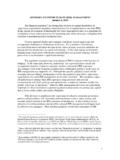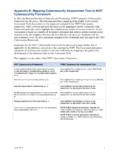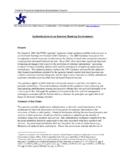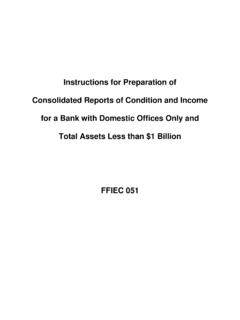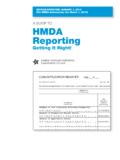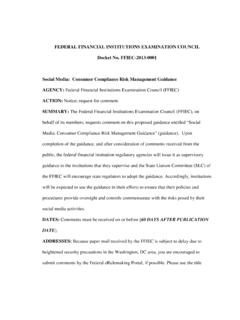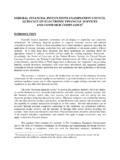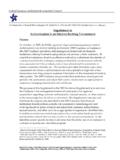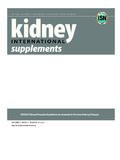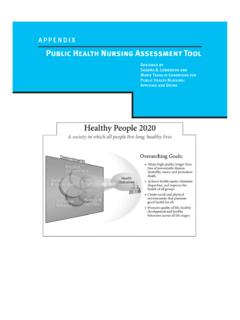Transcription of Appendix C: Glossary - FFIEC Home Page
1 Appendix C: Glossary Administrator privileges: Allow computer system-access to resources that are unavailable to most users. Administrator privileges permit execution of actions that would otherwise be restricted. Source: NSA/CSS Confidence in Cyber Space Air-gapped environment: Security measure that isolates a secure network from unsecure networks physically, electrically, and electromagnetically. Source: FFIEC Joint Statement - Destructive Malware Anomalous activity: The process of comparing definitions of what activity is considered normal against observed events to identify significant deviations.
2 Source: NIST: SP 800-94. Antivirus/Anti-malware software: A program that monitors a computer or network to identify all types of malware and prevent or contain malware incidents. Source: NIST Guide to Malware Incident Prevention and Handling for Desktops and Laptops Asset: In computer security, a major application, general-support system, high-impact program, physical plant, mission-critical system, personnel, equipment, or a logically related group of systems. Source: NIST: CNSSI-4009. Attack signature: A specific sequence of events indicative of an unauthorized access attempt. Source: NIST: SP 800-12.
3 Authentication: The process of verifying the identity of an individual user, machine, software component, or any other entity. Source: FFIEC Information Security Booklet Baseline configuration: A set of specifications for a system, or configuration item (CI) within a system, that has been formally reviewed and agreed on at a given point in time, and that can be changed only through change-control procedures. The baseline configuration is used as a basis for future builds, releases, or changes. Source: NIST: SP 800-128. Black holing: A method typically used by ISPs to stop a DDoS attack on one of its customers.
4 This approach to block DDoS attacks makes the site in question completely inaccessible to all traffic, both malicious attack traffic and legitimate user traffic. Source: NCCIC/US-CERT. DDoS Quick Guide Border router: A device located at the organization's boundary to an external network. Source: NIST: SP 800-41. Buffer overflow: A condition at an interface under which more input can be placed into a buffer or data-holding area than the capacity allocated, overwriting other information. Attackers exploit such a condition to crash a system or to insert specially crafted code that allows them to gain control of a system.
5 Source: NISTIR 7298 Revision 2. Business continuity: The ability to maintain operations and services both technology and business in the event of a disruption to normal operations and services. Ensures that any impact or disruption of services is within a documented and acceptable recovery time period and that system or operations are resumed at a documented and acceptable point in the processing cycle. Source: FFIEC IT Examination Handbook Glossary June 2015 1. FFIEC Cybersecurity Assessment Tool Appendix C: Glossary Change management: The broad processes for managing organizational change.
6 Change management encompasses planning, oversight or governance, project management, testing, and implementation. Source: FFIEC Operations Booklet CHIPS: A private-sector funds-transfer system, clearing and settling cross-border and domestic payments. Source: CHIPS. Cloud computing: Generally a migration from owned resources to shared resources in which client users receive information technology services on demand from third-party service providers via the Internet cloud. In cloud environments, a client or customer relocates its resources such as data, applications, and services to computing facilities outside the corporate firewall, which the end user then accesses via the Internet.
7 Source: FFIEC . Statement on Outsourced Cloud Computing Crisis management: The process of managing an institution's operations in response to an emergency or event that threatens business continuity. An institution's ability to communicate with employees, customers, and the media, using various communications devices and methods, is a key component of crisis management. Source: FFIEC Business Continuity Planning Booklet Critical system [infrastructure]: The systems and assets, whether physical or virtual, that are so vital that the incapacity or destruction of such may have a debilitating impact.
8 Source: NICCS Glossary Cyber attack: Attempts to damage, disrupt, or gain unauthorized access to a computer, computer system, or electronic communications network. An attack, via cyberspace, targeting an enterprise's use of cyberspace for the purpose of disrupting, disabling, destroying, or maliciously controlling a computing environment or infrastructure; or destroying the integrity of the data or stealing controlled information. Source: FFIEC IT. Examination Handbook Glossary Cyber event: A cybersecurity change or occurrence that may have an impact on organizational operations (including mission, capabilities, or reputation).
9 Source: NIST Cybersecurity Framework Cyber incident: Actions taken through the use of computer networks that result in an actual or potentially adverse effect on an information system or the information residing therein. Source: NIST: CNSSI-4009. Cyber threat: An internal or external circumstance, event, action, occurrence, or person with the potential to exploit technology-based vulnerabilities and to adversely impact (create adverse consequences for) organizational operations, organizational assets (including information and information systems), individuals, other organizations, or society.
10 Source: NICCS Glossary Cybersecurity: The process of protecting consumer and bank information by preventing, detecting, and responding to attacks. Source: Derived from NIST Cybersecurity Framework June 2015 2. FFIEC Cybersecurity Assessment Tool Appendix C: Glossary Data classification program: A program that categorizes data to convey required safeguards for information confidentiality, integrity, and availability; establishes controls required based on value and level of sensitivity. Source: Derived from SANS Institute InfoSec Reading Room Database: A collection of data that is stored on any type of computer storage medium and may be used for more than one purpose.
